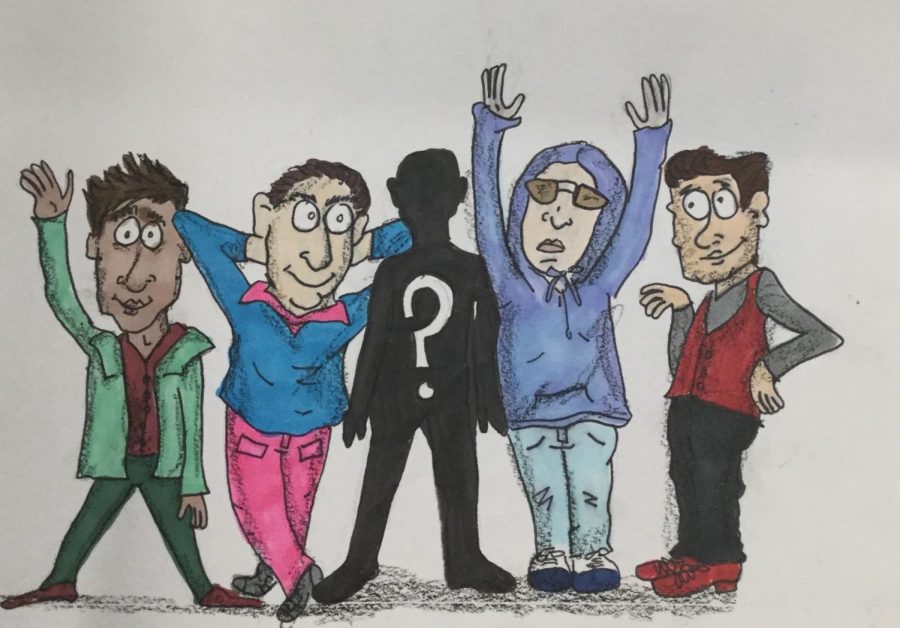I’m not just a: Gay Best Friend
Our society has constructed artificial schemas and expectations for who gay guys should be. We indulge this misconception by buying into the media’s often overly effeminate characterization of queer males. Damien from Mean Girls. Kurt from Glee. Walt from The Carrie Diaries. Anwar from Sex Education.
We’re unbothered when these men wear pink blazers or the skinniest of skinny jeans, just as we hardly bat an eye when we discover their self-professed love for shopping and sipping overpriced cappuccinos. What’s most problematic is that we fail to separate this dramatized perception of gay males from our reality, thus leading queer male students at our school feeling trapped and confined by this cliché Gay Best Friend (GBF) stereotype so often the subject of popular Netflix content.
For senior Chris Sciortino, the label GBF feels degrading. “GBF has who just follows you around with an iced coffee while you shop and sasses each outfit you try on,” said Sciortino. “To be honest, I actually hate shopping and caffeine gives me headaches, so not all of us fit into that stereotype.”
The frustration with this stereotype is echoed by senior Andrew Kline who expressed that many of his straight friends treat him like a prop.
“I’m the type of person that they want to take shopping, the type of person to watch a movie with when they’re bored, the person that they need involved in their drama – but not one they would invite to a party. In other words, my friendships can be one-dimensional. I silently blamed myself for the shortcomings of my friendships without giving thought to a larger role that I was consistently being placed in,” said Kline.
And when queer males refuse or fail to conform to these preconceived expectations, we’re often surprised and taken aback.
“So many people that I met coming in to New Trier said, ‘You know, you’re actually really chill.’ And each time my response would be an awkward, ‘Thank you?’ Society has ingrained one idea of a gay person into everybody’s head and for them meeting a gay person who does not fit the cookie-cutter mold is different. But there are still so many things people assume about me before they’ve even met me,” said Sciortino.
Because we’re so quick to group gay males into the romanticized role of the GBF, we sometimes forget that sexuality doesn’t define a person. Albeit one’s sexual orientation is a critical aspect of their identity, it remains a single part of who they are.
“What’s important to remember is even though I, or any gay person, seem to fit into one idea or stereotype of what a gay guy is like, that’s not the extent of our personality or our character. There is so much more to that person than their sexuality. Not all gay guys love to go shopping and gossip. Just like not all straight guys like to play football and watch sports all the time,” said Sciortino.
The struggle for numerous gay males to accept and be comfortable with their sexuality in a predominantly heterosexual high school environment is one that should be recognized.
“At first I was obsessed with fitting in and acting straight in order to fit in. But after reflecting for a long time I realized that fitting in is so incredibly boring. I want to stand out from the crowd and express myself in ways that other people don’t,” said senior Connor Hester.
But despite the self-acceptance that these students have reached, some still feel like outsiders in a community that has promised to provide a safe, welcoming environment.
An anonymous student communicated his anger and belief that members of the New Trier faculty have failed to appropriately identify and acknowledge homophobia.
“At Cross Country practices, meets, and other events, I frequently heard the F-word and listened to my teammates make fun of queer people. Freshman year I was petrified I would never make friends and I was in a situation where I felt effectively silenced. I would be able to understand if a coach was unable to hear these statements, but comments were also uttered in the presence of faculty,” said an anonymous student.
For Hester, the awkwardness of being a gay student at New Trier was felt by various micro-aggressions from homophobes who he associated with when he was closeted.
“At New Trier gays exist in the oh-so-uncomfortable middle ground of ‘Tolerance.’ I can still see the people who can’t help but stare and I’ve noticed the people who have distanced themselves from me as I’ve changed and become more comfortable in my own skin. This isn’t to say that there aren’t excellent resources available to students, and not everyone who is gay feels this way,” said Hester.
Despite the numerous battles and obstacles that are still inherent parts of being a queer student in high school, Hester believes that coming to a resolution of one’s sense of self is ultimately worth it.
“It takes courage to be out in high school, to constantly worry about what people think of you while you walk through the hallways, and to willingly to express yourself despite any backlash that you may receive. But everyone deserves to be themselves. No one should have to pretend to be someone else in order to make friends and survive a toxic social climate like New Trier’s,” said Hester.







































